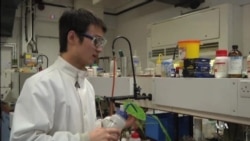Having an automobile can be costly. In addition to paying for fuel, the owner of a car should set aside money for an insurance policy to guard against possible damage or loss. The owner also has to pay for normal repairs, like an oil change, and other work.
Another cost is cleaning. Cars get dirty, even under the best of conditions. Who would not want a car that is always clean because drops of water and oil just roll off? Now, scientists say it may not be too long before self-cleaning paints become more common in many industries.
It has been long known that rainwater slides off the leaves of some plants without leaving a mark. Soon, the same may be true for raindrops on your car.
Scientists can now reproduce that quality, or property, of tropical plants like the taro and lotus. Researchers are able to do this because of developments in nanophysics: the studies of very small particles.
Yao Lu is a researcher from China’s Dalian University of Technology. He currently works at University College London. He used titanium dioxide nanoparticles to create a new kind of water-repellent paint. Water droplets do not leave a mark on the painted surface.
Yao Lu’s supervisor is inorganic chemistry professor Claire Carmalt. She says that when water hits a surface covered with this paint, it does not just slide off.
“It actually forms near spherical-shaped balls which, as they roll across the surface, act like miniature vacuum cleaners, picking up dirt and bacteria. And we can take that paint and we can adhere it into hard surfaces, like glass or metal, or soft surfaces like cotton and paper, just using simple adhesives.”
Up until now, the biggest problem with water-repellent paints was their vulnerability to mechanical damage. In other words, the machinery or other equipment covered with the paint was easily damaged. This was solved with a special adhesive or glue that sticks to the titanium dioxide nanoparticles.
“Applying this spray adhesive, we’ve managed to get very resistant coatings that are resistant to, as I say, rubbing or scratching and with sandpaper and so on.”
The new kind of paint can be used on a number of materials, from clothing and paper to steel and glass. Researchers say the paint could be used in a factory or other large-scale manufacturing. They predict this product could be used in a number of areas, including auto manufacturing and even hospitals.
I’m Jim Tedder.
VOA correspondent George Putic reported this story from Washington. George Grow wrote it for Learning English. Caty Weaver was the editor.
______________________________________________________________
Words in This Story
insurance – adj. protecting against possible damage or loss; n. protecting something against damage or loss with a contract or agreement
tropical – adj. relating to an area or climate where temperatures never reach freezing (0 degrees Celsius)
repellent – adj. keeping something away; resistant
vacuum cleaner – n. a machine that cleans floors, floor coverings
adhere – v. to stick to something: to attach firmly to something





